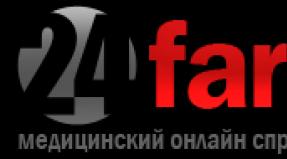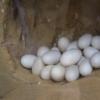Introduction. Pro-inflammatory and anti-inflammatory cytokines: classification and properties Cytokines that provoke inflammatory processes
Cytokines- this is an extensive family of biologically active peptides that have a hormone-like effect and ensure the interaction of cells of the immune, hematopoietic, endocrine and nervous systems.
Depending on the producer cells, interleukins, monokines and lymphokines are distinguished. The collection of cytokines of the immune system forms a "cytokine cascade". Antigenic stimulation leads to the secretion of "first generation" cytokines - tumor necrosis factor α, interleukins -1 β and - δ, which induce the biosynthesis of the central regulatory cytokine IL-2, as well as IL-3, IL-4, IL- 5, γ-interferon (second generation cytokines). In turn, second-generation cytokines affect the biosynthesis of early cytokines. This principle of action allows an ever-increasing number of cells to be involved in the reaction.
The main producers of cytokines are T-helpers and macrophages.
In the process of growth and differentiation of blood cells, as well as the development of an immune response, modulation (induction, strengthening, weakening) of receptor expression occurs, as a result of which the ability of a particular cell to respond to a certain cytokine changes. Cytokines often serve as modulators of receptor expression, and in some cases, a cytokine is able to change the expression of its own receptor.
The main properties of cytokines:
- synthesized during the immune response;
- regulate the immune response process;
- are active at very low concentrations;
- are factors of growth and differentiation of cells;
- able to perform several functions in a wide range of tissues and cells (pleiotropic effect);
- able to have similar biological effects (duplication phenomenon);
- can be produced by a wide variety of cells.
Pro-inflammatory cytokines include IL-1β, IL-2, IL-6, IL-8, γ-IFN, TNF-α, and anti-inflammatory cytokines - IL-4, IL-10, IL-13.
Today, the following classes of cytokines are distinguished:
- interleukins (performing numerous functions);
- interferons (limit the spread of intracellular infections and have an immunoregulatory effect);
- colony-stimulating factors (regulate the differentiation and division of leukocyte precursors);
- chemokines (rehearse cell migration to the focus of inflammation);
- tumor necrosis factors (have a pro-inflammatory effect and mediate the induction of apoptosis of compromised cells);
- growth factors (regulate the proliferation of various cells, which promotes wound healing and replenishment of defects caused by inflammation).
Granulocyte-macrophage colony-stimulating factor α
Granulocyte-macrophage colony-stimulating factor α (GM-CSF-α) along with IL-3 belongs to early pluripotent hematopoietic factors. Supports clonal growth of bone marrow progenitors of macrophage granulocytes. Mature granulocytes, monocytes, and eosinophils also serve as target cells for GM-CSF. It stimulates the antimicrobial and antitumor activity of neutrophils, eosinophils and macrophages, induces the biosynthesis of certain cytokines by them (TNF-α, IL-1, M-CSF). GM-CSF inhibits the migration of neutrophils, contributing to their accumulation in the area of inflammation. Producers of GM-CSF are stimulated T-lymphocytes, monocytes, fibroblasts, endothelial cells.
Granulocyte colony stimulating factor
Granulocyte colony stimulating factor (G-CSF) is a more recent hematopoietic factor than GM-CSF. Stimulates the growth of colonies almost exclusively of granulocytes and activates mature neutrophils. It is secreted by macrophages, fibroblasts, endothelial cells and bone marrow stroma. The clinical application of G-CSF is aimed at restoring the number of neutrophils in the blood in leukopenia.
macrophage colony stimulating factor
Macrophage colony stimulating factor (M-CSF) stimulates the digging of macrophage colonies from bone marrow progenitors. Causes proliferation and activates mature macrophages, inducing their biosynthesis of IL-1β, G-CSF, interferons, prostaglandins, increasing their cytotoxicity against infected and tumor cells. Cytokine producers are fibroblasts, endothelial cells and lymphocytes.
Erythropoietin
Erythropoietin is the main cytokine that regulates the formation of erythrocytes from immature bone marrow precursors. The main organ in which erythropoietin is formed during neonatal development is the liver. In the postnatal period, it is produced primarily at night.
Chemokines are specialized cytokines that cause the directed movement of leukocytes. More than 30 different chemokines have been described in humans.
Chemokines are produced by leukocytes, platelets, endothelial cells, epithelial cells, fibroblasts, and some other cells. The production of chemokines is regulated by pro- and anti-inflammatory cytokines. Chemokines are classified according to the location of the first two cysteine residues in the molecule. In this case, the following types of molecules are distinguished:
- α-chemokines - neutrophil chemoattractants (IL-8, IL-10, etc.);
- β-chemokines - take part in the development of protracted inflammation (RANTES, MIP-1, -2, -3, -4);
- γ-chemokines - chemoattractants of CD4 + and CD8 + T-lymphocytes, as well as natural killers (lymphotactin);
- fractalkin, a T-lymphocyte-specific chemokine;
- chemokines of a lipid nature (in particular, platelet-activating factor).
Tumor necrosis factor α (TNF-α) is one of the central regulators of innate immunity (along with IL-1β, α/β-IFN). Shows a lot of biological activities, a significant part of which is similar to IL-1β. Prolonged stay of TNF-α in the bloodstream leads to depletion of muscle and adipose tissue (cachexia) and suppression of hematopoiesis. Many of the biological effects of TNF-α are potentiated by IFN-γ. The main cytokine-producing cells are macrophages that secrete it when stimulated by bacterial products, as well as natural killers (NK).
lymphotoxin
Lymphotoxin (LT, TNF-β) is one of the first described cytokines. The biological activity spectra of LT and TNF-α are identical. Cytokines may play a role in antitumor, antiviral immunity, and immunoregulation. Cells-producers of LT are activated T-lymphocytes. material from the site
Transforming growth factor β (TGF-β) is a polyfunctional cytokine secreted by T-lymphocytes at the late stages of activation and has a suppressive effect on the proliferation of T- and B-cells. May also be produced by macrophages, platelets, cells
In case of failure of local protective reactions, an inflammatory reaction develops, the synthesis of cytokines increases, they enter the circulation, and their action is manifested at the systemic level. A systemic inflammatory reaction or an acute phase response begins at the body level. At the same time, pro-inflammatory cytokines affect almost all organs and systems of the body involved in the regulation of homeostasis.
The action of pro-inflammatory cytokines on the CNS leads to a decrease in appetite and a change in the entire complex of behavioral reactions. A temporary cessation of foraging and a decrease in sexual activity is beneficial in terms of energy savings for the sole purpose of combating an invading pathogen. This signal is provided by cytokines, since their entry into the circulation, of course, means that the local defense has not coped with the pathogen and the inclusion of a systemic inflammatory response is required. One of the first manifestations of a systemic inflammatory response associated with the action of cytokines on the thermoregulatory center of the hypothalamus is an increase in body temperature. An increase in temperature is one of the effective protective reactions, since at an elevated temperature the ability of a number of bacteria to reproduce decreases, and, on the contrary, the proliferation of lymphocytes increases.
In the liver, under the influence of cytokines, the synthesis of acute-phase proteins and components of the complement system, which are necessary to fight the pathogen, increases, but at the same time the synthesis of albumin decreases. That is, at the level of regulation of the expression of individual genes, cytokines direct energy flows, choosing only what is needed for the development of protective reactions. Apparently, such a system of regulation has evolved and has unconditional benefits for the most optimal protective response of the macroorganism. Another example of the selective action of cytokines is the change in the ionic composition of blood plasma during the development of a systemic inflammatory response. In this case, there is a decrease in the level of iron ions, but an increase in the level of zinc ions, and it is well known that depriving a bacterial cell of iron ions means reducing its proliferative potential (the action of lactoferrin is based on this). On the other hand, an increase in the level of zinc is necessary for the normal functioning of the immune system, in particular, it is necessary for the formation of a biologically active serum thymus factor, one of the main thymic hormones that ensures the differentiation of lymphocytes. The effect of cytokines on the hematopoietic system is associated with a significant activation of hematopoiesis. An increase in the number of leukocytes, of course, is necessary to increase the number of cells that directly kill pathogens and to replenish the loss of neutrophilic granulocytes in the focus of purulent inflammation. The action on the blood coagulation system is aimed at enhancing clotting, which is necessary to stop bleeding and to directly block the pathogen. Finally, within the immune system, cytokines mediate the relationship between nonspecific defense responses and specific immunity, acting in both directions. Thus, at the level of the body, cytokines communicate between the immune, nervous, endocrine, hematopoietic, and other systems and serve to involve them in the organization and regulation of a single defense reaction. Cytokines just serve as the organizing system that forms and regulates the entire complex of protective reactions of the body during the introduction of pathogens. These data clearly indicate that the concept of defense reactions cannot be limited to the participation of nonspecific resistance mechanisms and a specific immune response. The whole body and all systems that at first glance do not relate to the maintenance of immunity participate in a single protective reaction. The increase in cytokine levels cannot continue uncontrollably, since the hyperproduction of cytokines causes the development of a number of pathological conditions, in particular, septic shock. The appearance of cytokines in the bloodstream immediately leads to an increase in the synthesis of steroid hormones, and IL-1 and other pro-inflammatory cytokines cause both an increase in the synthesis of releasing factors and stimulation of hormone production by the cells of the adrenal cortex. Steroid hormones, known as one of the most powerful immunosuppressors, block the synthesis of cytokines and do not allow their level to exceed the limit values. This is an effective negative feedback mechanism to control cytokine overproduction. However, in some cases, cytokine levels exceed physiological concentrations. Cytokines in low concentrations are needed for the correct formation of local inflammation, higher doses cause the development of a systemic inflammatory response, but pathologically high concentrations lead to a state of septic shock and death of the body.
10030 0
Pro-inflammatory cytokines
TNF-α, IL-1, IL-6 and IL-8 belong to the group of pro-inflammatory cytokines, which are of particular importance in the pathogenesis of inflammatory rheumatic diseases. TNF-α and IL-1 are synthesized in parallel, have the ability to induce each other's production and exhibit numerous common effects.TNF-α in structure it resembles transmembrane molecules and is synthesized by monocytes, macrophages and lymphocytes under the influence of endotoxins, viruses and other cytokines. There are two types of TNF receptors on target cells. A soluble form of the receptor has been found, which is also involved in the realization of the biological effects of TNF-α. TNF-α is a very important pro-inflammatory cytokine, which is also involved in the development of cachexia in malignant neoplasms. A pronounced increase in the concentration of TNF-α is found in patients with sepsis and correlates with an unfavorable prognosis.
TNF-alpha, along with IL-1, plays an important role in cartilage destruction in RA. However, in SLE, a decrease in TNF-α production is associated with HLA-DR4 carriage and a low incidence of nephritis. Administration of recombinant TNF-α to mice with spontaneously developing lupus-like disease (NZBxNZW F1) suppresses disease activity. Thus, TNF-α may be involved in both the development and prevention of autoimmune pathology.
IL-1 the family consists of three molecules: IL-1 α, IL-1 β and an IL-1 receptor antagonist. IL-1 α and IL-1 β are synthesized by macrophages and monocytes, as well as by ECs, epithelial cells, fibroblasts, activated T-lymphocytes, and others. membrane bound form.
Two types of IL-1 receptors have been described: type 1 IL-1 R is present on T cells, ECs, fibroblasts, while type II is expressed on B cells, monocytes, and neutrophils (S. K. Dower and J. E. Smith, 1990). The expression of Ё-1B is suppressed by TGF-β, which determines the immunosuppressive activity of this cytokine. IL-1 exhibits not only local, but also systemic effects, which include fever, muscle weakness, synthesis of acute phase proteins (along with IL-6 and IL-11) and many others (C. A. Dinarello, 1989; E. L. Nasonov, 1987)
IL-6 synthesized by many cells, including cells of the synovial membrane of the joint, and stimulates the formation of IL-1 and TNF-alpha. IL-6 is involved in the differentiation of stimulated B-lymphocytes into immunoglobulin-secreting plasma cells and in the regulation of the acute phase response (T. Hirano et al., 1990). An increase in serum IL-6 concentration was found in many inflammatory diseases, it correlates with laboratory markers of inflammation activity: ESR and especially CRP concentration. cerebrospinal fluid in lupus cerebrovasculitis, in synovial fluid in RA.
The serum level of IL-6 correlates with the severity of the process in myeloma. Hyperproduction of IL-6 plays an important role in the development of hypergammaglobulinemia and production of autoantibodies in atrial myxoma, local RF synthesis in RA, and autoantibody synthesis in SLE. It is assumed that RA and myeloma belong to the so-called IL-6-dependent human diseases. IL-6 accelerates the progression of the process in NZB/NZW F1 mice with lupus-like syndrome (B. K. Finch et al., 1994). The introduction of monoclonal antibodies to IL-6 suppresses the activity of the process in PA (D. Wendling et al. 1993) and the progression of the disease in NZB/NZW F1 mice (B. K. Finch et al. 1994).
IL-8(4q12-q21 monocytic factor) is a member of the peptide family with a mol. weighing 8kD, involved in specific chemotaxis, regulation of inflammation and cell growth (M. Baggiolini et al., 1989). IL-8 causes the activation of T-lymphocytes and neutrophils, chemotaxis and edema formation, inhibits the adhesion of neutrophils to cytokine-activated ECs, and thereby attenuates neutrophil-mediated damage to ECs in the area of inflammation. TNF-α and IL-1 stimulate the synthesis of IL-8 by monocytes, macrophages, ECs, fibroblasts and other cells. It is believed that IL-8 plays an important role in the development of arthritis by directing the movement of neutrophils into the joint cavity. In addition, IL-8 enhances the functional activity of neutrophils, including the expression of adhesion molecules, the formation of oxygen radicals, and the release of lysosomal enzymes.
Growth and differentiation factors
Growth and differentiation factors, whose properties, along with platelet and epidermal growth factors, TGF-β and fibroblast growth factor, etc., have some cytokines, play an important role in fibroblast proliferation and angiogenesis in chronic human diseases, including rheumatic ones. It is also believed that TGF-β is involved in the development of acute inflammation.Platelet growth factor is synthesized mainly by platelets and to a lesser extent by macrophages, endothelial and other cells. Epidermal growth factor is produced by many cells and, along with fibroblast growth factor, plays an important role in angiogenesis. In addition, both of these factors induce the proliferation and growth of various epithelial and mesenchymal cells. It has been established that these growth factors are present in the synovial fluid in RA and are synthesized by synovial macrophages.
It is assumed that the proliferation of synovial fibroblasts of the rheumatoid synovium is associated with the action of all three of these growth factors, and a sharp increase in the growth of new capillaries in the rheumatoid synovium is associated with the influence of the last two. Tissue fibrosis, which is a characteristic feature of SJS, is likely the result of uncontrolled production of platelet, epidermal, and fibroblast growth factors.
TGF-P, which has both pro-inflammatory and anti-inflammatory activity, is of great importance in the development of rheumatic diseases (W. A. Border and N. Noble, 1994). TGF-beta stimulates the accumulation of monocytes in tissues, regulates the functional activity of lymphocytes and macrophages, and stimulates tissue fibrosis. It is noteworthy that, depending on the presence of other cytokines, TGFβ is able to both suppress and stimulate the growth and differentiation of fibroblasts.
TGF-beta stimulates the synthesis of collagen and fibronectin by fibroblasts, while IF-y and TNF-α have the opposite effect. In the presence of platelet growth factor, epidermal growth factor and fibroblast growth factor, TGF-β inhibits the synthesis of collagenase and other neutral proteases and increases the production of inhibitors of these enzymes. TGF-β is supposed to be involved in the development of fibrosis in SSc. It has been shown that monocytes infiltrating the skin and tissues in SJS contain TGF-beta mRNA. In addition, TGF-β is present in the area of skin fibrosis near the fibroblasts.
An important property of TGF-β is the ability to modulate certain activities of monocytes and lymphocytes. It has been shown that TGF-β is the most potent chemotactic agent for monocytes currently known, causes an increase in expression, but inhibits the synthesis of cytokines, suppresses IL-1-induced proliferation of T-lymphocytes, growth and synthesis of immunoglobulins by B-lymphocytes, and inhibits the activity of NK -cells. On the one hand, TGF-β, causing the accumulation of monocytes, edema, redness and hyperplasia of synovial fibroblasts, induces the development of inflammation, and on the other hand, it has the ability to reduce the expression of HLA-Dr and the synthesis of oxygen radicals by monocytes.
E.L. Nasonov
A. Interferons (IFN):
1. Natural IFN (1 generation):
2. Recombinant IFN (2nd generation):
a) short action:
IFN a2b: intron-A
IFN β: Avonex and others.
(pegylated IFN): peginterferon
B. Interferon inducers (interferonogens):
1. Synthetic- cycloferon, tiloron, dibazol and etc.
2. Natural- ridostin, etc.
AT. Interleukins : recombinant interleukin-2 (roncoleukin, aldesleukin, proleukin, ) , recombinant interleukin 1-beta (betaleukin).
G. colony stimulating factors (molgramming, etc.)
Peptide preparations
Thymic peptide preparations .
Peptide compounds produced by the thymus gland stimulate the maturation of T-lymphocytes(thymopoietins).
With initially low levels, preparations of typical peptides increase the number of T-cells and their functional activity.
The founder of thymic preparations of the first generation in Russia was Taktivin, which is a complex of peptides extracted from the thymus of cattle. Thymic peptide complex preparations also include Timalin, Timoptin and others, and to those containing thymus extracts - Timimulin and Vilozen.
Preparations of peptides from bovine thymus thymalin, thystimulin administered intramuscularly and taktivin, timoptin- under the skin, mainly in case of insufficiency of cellular immunity:
With T-immunodeficiencies,
viral infections,
For the prevention of infections during radiation therapy and chemotherapy of tumors.
The clinical efficacy of first-generation thymic preparations is not in doubt, but they have one drawback: they are an undivided mixture of biologically active peptides that are rather difficult to standardize.
Progress in the field of drugs of thymic origin went along the line of creating drugs of the II and III generations - synthetic analogues of natural thymus hormones or fragments of these hormones with biological activity.
Modern drug Imunofan - hexapeptide, a synthetic analogue of the active center of thymopoietin, is used for immunodeficiencies, tumors. The drug stimulates the formation of IL-2 by immunocompetent cells, increases the sensitivity of lymphoid cells to this lymphokine, reduces the production of TNF (tumor necrosis factor), has a regulatory effect on the production of immune mediators (inflammation) and immunoglobulins.
Bone marrow peptide preparations
Myelopid obtained from a culture of bone marrow cells of mammals (calves, pigs). The mechanism of action of the drug is associated with stimulation of the proliferation and functional activity of B- and T-cells.
In the body, the target of this drug are B-lymphocytes. In violation of immuno- or hematopoiesis, the introduction of myelopide leads to an increase in the overall mitotic activity of bone marrow cells and the direction of their differentiation towards mature B-lymphocytes.
Myelopid is used in the complex therapy of secondary immunodeficiency states with a predominant lesion of the humoral immunity, for the prevention of infectious complications after surgical interventions, injuries, osteomyelitis, nonspecific pulmonary diseases, chronic pyoderma. Side effects of the drug are dizziness, weakness, nausea, hyperemia and soreness at the injection site.
All drugs in this group are contraindicated in pregnant women, myelopid and imunofan are contraindicated in the presence of Rhesus conflict between mother and fetus.
Immunoglobulin preparations
Human immunoglobulins
a) Immunoglobulins for intramuscular injection
Non-specific: normal human immunoglobulin
Specific: immunoglobulin against human hepatitis B, human antistaphylococcal immunoglobulin, human tetanus immunoglobulin, human immunoglobulin against tick-borne encephalitis, human immunoglobulin against rabies virus, etc.
b) Immunoglobulins for intravenous administration
Non-specific: normal human immunoglobulin for intravenous administration (gabriglobin, immunovenin, intraglobin, humaglobin)
Specific: immunoglobulin against human hepatitis B (neohepatect), pentaglobin (contains antibacterial IgM, IgG, IgA), immunoglobulin against cytomegalovirus (cytotect), human immunoglobulin against tick-borne encephalitis, anti-rabies IG, etc.
c) Immunoglobulins for oral administration: immunoglobulin complex preparation (CIP) for enteral use in acute intestinal infections; anti-rotavirus immunoglobulin for oral administration.
Heterologous immunoglobulins:
anti-rabies immunoglobulin from horse serum, anti-gangrenous polyvalent horse serum, etc.
Preparations of nonspecific immunoglobulins are used for primary and secondary immunodeficiencies, preparations of specific immunoglobulins - for relevant infections (for therapeutic or prophylactic purposes).
Cytokines and preparations based on them
The regulation of the developed immune response is carried out by cytokines - complex complex of endogenous immunoregulatory molecules, which are the basis for creating a large group of both natural and recombinant immunomodulatory drugs.
Interferons (IFN):
1. Natural IFN (1 generation):
Alphaferons: human leukocyte IFN, etc.
Betaferons: human fibroblastic IFN, etc.
2. Recombinant IFN (2nd generation):
a) short action:
IFN a2a: reaferon, viferon, etc.
IFN a2b: intron-A
IFN β: Avonex and others.
b) prolonged action(pegylated IFN): peginterferon (IFN a2b + Polyethylene glycol), etc.
The main direction of action of IFN drugs is T-lymphocytes (natural killers and cytotoxic T-lymphocytes).
Natural interferons are obtained in a culture of donor blood leukocyte cells (in a culture of lymphoblastoid and other cells) under the influence of an inducer virus.
Recombinant interferons are obtained by a genetic engineering method - by cultivating bacterial strains containing in their genetic apparatus an integrated recombinant human interferon gene plasmid.
Interferons have antiviral, antitumor and immunomodulatory effects.
As antiviral agents, interferon preparations are most effective in the treatment of herpetic eye diseases (locally in the form of drops, subconjunctival), herpes simplex with localization on the skin, mucous membranes and genitals, herpes zoster (locally in the form of a hydrogel-based ointment), acute and chronic viral hepatitis B and C (parenterally, rectally in suppositories), in the treatment and prevention of influenza and SARS (intranasally in the form of drops). In HIV infection, recombinant interferon preparations normalize immunological parameters, reduce the severity of the disease in more than 50% of cases, cause a decrease in the level of viremia and the content of serum markers of the disease. In AIDS, combination therapy with azidothymidine is carried out.
The antitumor effect of interferon preparations is associated with an antiproliferative effect and stimulation of the activity of natural killers. IFN-alpha, IFN-alpha 2a, IFN-alpha-2b, IFN-alpha-n1, IFN-beta are used as antitumor agents.
IFN-beta-lb is used as an immunomodulator in multiple sclerosis.
Interferon preparations cause similar side effects. Characteristic - influenza-like syndrome; changes from the side of the central nervous system: dizziness, blurred vision, confusion, depression, insomnia, paresthesia, tremor. From the gastrointestinal tract: loss of appetite, nausea; on the part of the cardiovascular system, symptoms of heart failure are possible; from the urinary system - proteinuria; from the hemopoietic system - transient leukopenia. Rash, itching, alopecia, temporary impotence, nosebleeds may also occur.
Interferon inducers (interferonogens):
1. Synthetic - cycloferon, tiloron, poludan, etc.
2. Natural - ridostin, etc.
Interferon inductors are drugs that enhance the synthesis of endogenous interferon. These drugs have a number of advantages over recombinant interferons. They do not have antigenic activity. Stimulated synthesis of endogenous interferon does not cause hyperinterferonemia.
Tiloron(amiksin) refers to low molecular weight synthetic compounds, is an oral interferon inducer. It has a wide spectrum of antiviral activity against DNA and RNA viruses. As an antiviral and immunomodulatory agent, it is used for the prevention and treatment of influenza, SARS, hepatitis A, for the treatment of viral hepatitis, herpes simplex (including urogenital) and herpes zoster, in the complex therapy of chlamydial infections, neuroviral and infectious-allergic diseases, with secondary immunodeficiencies. The drug is well tolerated. Possible dyspepsia, short-term chills, increased overall tone, which does not require discontinuation of the drug.
Poludan is a biosynthetic polyribonucleotide complex of polyadenylic and polyuridylic acids (in equimolar ratios). The drug has a pronounced inhibitory effect on herpes simplex viruses. It is used in the form of eye drops and injections under the conjunctiva. The drug is prescribed for adults for the treatment of viral eye diseases: herpetic and adenovirus conjunctivitis, keratoconjunctivitis, keratitis and keratoiridocyclitis (keratouveitis), iridocyclitis, chorioretinitis, optic neuritis.
Side effects occur rarely and are manifested by the development of allergic reactions: itching and sensation of a foreign body in the eye.
Cycloferon- low molecular weight interferon inducer. It has antiviral, immunomodulatory and anti-inflammatory effects. Cycloferon is effective against tick-borne encephalitis, herpes, cytomegalovirus, HIV, etc. viruses. It has an antichlamydial effect. Effective in systemic connective tissue diseases. The radioprotective and anti-inflammatory effect of the drug was established.
Arbidol is prescribed orally for the prevention and treatment of influenza and other acute respiratory viral infections, as well as for herpetic diseases.
Interleukins:
recombinant IL-2 (aldesleukin, proleukin, roncoleukin ) , recombinant IL-1beta ( betaleykin).
Cytokine preparations of natural origin, containing a sufficiently large set of cytokines of inflammation and the first phase of the immune response, are characterized by a multifaceted effect on the human body. These drugs act on cells involved in inflammation, regeneration processes, and the immune response.
Aldesleukin- recombinant analogue of IL-2. It has an immunomodulatory and antitumor effect. Activates cellular immunity. Enhances the proliferation of T-lymphocytes and IL-2-dependent cell populations. Increases the cytotoxicity of lymphocytes and killer cells that recognize and destroy tumor cells. Enhances the production of interferon gamma, TNF, IL-1. Used for kidney cancer.
Betaleukin- recombinant human IL-1 beta. Stimulates leukopoiesis and immune defense. It is administered under the skin or intravenously in purulent processes with immunodeficiency, with leukopenia as a result of chemotherapy, with tumors.
Roncoleukin- a recombinant preparation of interleukin-2 - is administered intravenously for sepsis with immunodeficiency, as well as for kidney cancer.
Colony stimulating factors:
Molgramostim(Leikomax) is a recombinant preparation of human granulocyte-macrophage colony-stimulating factor. Stimulates leukopoiesis, has immunotropic activity. It enhances the proliferation and differentiation of precursors, increases the content of mature cells in the peripheral blood, the growth of granulocytes, monocytes, macrophages. Increases the functional activity of mature neutrophils, enhances phagocytosis and oxidative metabolism, providing mechanisms for phagocytosis, increases cytotoxicity against malignant cells.
Filgrastim(Neupogen) is a recombinant preparation of human granulocyte colony stimulating factor. Filgrastim regulates the production of neutrophils and their entry into the blood from the bone marrow.
Lenograstim- recombinant preparation of human granulocyte colony stimulating factor. It is a highly purified protein. It is an immunomodulator and a leukopoiesis stimulator.
Synthetic immunostimulants: levamisole, polyoxidonium isoprinosine, galavit.
Levamisole(decaris), an imidazole derivative, is used as an immunostimulant, as well as an antihelminthic agent for ascariasis. The immunostimulating properties of levamisole are associated with an increase in the activity of macrophages and T-lymphocytes.
Levamisole is prescribed orally for recurrent herpetic infections, chronic viral hepatitis, autoimmune diseases (rheumatoid arthritis, systemic lupus erythematosus, Crohn's disease). The drug is also used for tumors of the large intestine after surgical, radiation or drug therapy of tumors.
Isoprinosine- a drug containing inosine. Stimulates the activity of macrophages, the production of interleukins, the proliferation of T-lymphocytes.
Assign inside for viral infections, chronic infections of the respiratory and urinary tract, immunodeficiencies.
Polyoxidonium- synthetic water-soluble polymer compound. The drug has an immunostimulating and detoxifying effect, increases the body's immune resistance against local and generalized infections. Polyoxidonium activates all factors of natural resistance: cells of the monocyte-macrophage system, neutrophils and natural killers, increasing their functional activity at initially reduced levels.
Galavit is a derivative of phthalhydrazide. The peculiarity of this drug is the presence of not only immunomodulatory, but also pronounced anti-inflammatory properties.
Drugs of other pharmacological classes with immunostimulatory activity
1. Adaptogens and herbal preparations (phytopreparations): preparations of echinacea (immunal), eleutherococcus, ginseng, rhodiola rosea, etc.
2. Vitamins: ascorbic acid (vitamin C), tocopherol acetate (vitamin E), retinol acetate (vitamin A) (see section "Vitamins").
Echinacea preparations have immunostimulatory and anti-inflammatory properties. When taken orally, these drugs increase the phagocytic activity of macrophages and neutrophils, stimulate the production of interleukin-1, the activity of T-helpers, and the differentiation of B-lymphocytes.
Echinacea preparations are used for immunodeficiencies and chronic inflammatory diseases. In particular, immunal administered orally in drops for the prevention and treatment of acute respiratory infections, as well as together with antibacterial agents for infections of the skin, respiratory and urinary tract.
General principles for the use of immunostimulants in patients with secondary immunodeficiencies
The most reasonable use of immunostimulants seems to be in immunodeficiencies, manifested by increased infectious morbidity. Secondary immunodeficiencies remain the main target of immunostimulating drugs, which are manifested by frequent recurrent, difficult-to-treat infectious and inflammatory diseases of all localizations and any etiology. At the heart of each chronic infectious and inflammatory process are changes in the immune system, which are one of the reasons for the persistence of this process.
Immunomodulators are prescribed in complex therapy simultaneously with antibiotics, antifungal, antiprotozoal or antiviral agents.
· When carrying out immunorehabilitation measures, in particular in case of incomplete recovery after an acute infectious disease, immunomodulators can be used as monotherapy.
· It is advisable to use immunomodulators against the background of immunological monitoring, which should be carried out regardless of the presence or absence of initial changes in the immune system.
Immunomodulators acting on the phagocytic link of immunity can be prescribed to patients with both identified and undiagnosed immune status disorders, i.e. the basis for their use is the clinical picture.
A decrease in any parameter of immunity, revealed during an immunodiagnostic study in a practically healthy person, not necessarily is the basis for the appointment of immunomodulatory therapy.
Test questions:
1. What are immunostimulants, what are the indications for immunotherapy, what types of immunodeficiency states are divided into?
2. Classification of immunomodulators according to the preferential selectivity of action?
3. Immunostimulants of microbial origin and their synthetic analogues, their pharmacological properties, indications for use, contraindications, side effects?
4. Endogenous immunostimulants and their synthetic analogues, their pharmacological properties, indications for use, contraindications, side effects?
5. Preparations of thymic peptides and bone marrow peptides, their pharmacological properties, indications for use, contraindications, side effects?
6. Immunoglobulin preparations and interferons (IFN), their pharmacological properties, indications for use, contraindications, side effects?
7. Preparations of interferon inducers (interferonogens), their pharmacological properties, indications for use, contraindications, side effects?
8. Preparations of interleukins and colony-stimulating factors, their pharmacological properties, indications for use, contraindications, side effects?
9. Synthetic immunostimulants, their pharmacological properties, indications for use, contraindications, side effects?
10. Drugs of other pharmacological classes with immunostimulatory activity and general principles for the use of immunostimulants in patients with secondary immunodeficiencies?
6320 0
The immune system is regulated by soluble mediators called cytokines. These low molecular weight proteins are produced by virtually all cells of the innate and adaptive immune systems, and in particular by CD4+ T cells, which regulate many effector mechanisms. An important functional property of cytokines is the regulation of the development and behavior of effector cells of the immune system.
Some cytokines directly affect the synthesis and function of other cytokines. To make it easier to imagine how cytokines work, let's compare them with hormones - chemical mediators of the endocrine system. Cytokines serve as chemical messengers within the immune system, although they also interact with certain cells in other systems, including the nervous system. Thus, they are involved in maintaining homeostasis.
However, they play a significant role in the management of hypersensitivity and inflammatory response and in some cases may contribute to the development of acute or chronic damage to tissues and organs.
Regulated by a particular cytokine, must express the receptor for that factor. The positive and/or negative regulation of cellular activity depends on the amount and type of cytokines to which the cell is sensitive, as well as on the increase or decrease in the expression of cytokine receptors. Normally, a complex of these methods is involved in the regulation of innate and acquired immune responses.
History of cytokines
The activity of cytokines was discovered at the end of 1960. Initially, it was assumed that they serve as amplification factors that act in an antigen-dependent manner, increasing the proliferative responses of T cells. lymphocyte activating factor (LAF). This view was radically changed when it was found that the supernatant of mitogen-stimulated peripheral blood mononuclear cells induces prolonged T-cell proliferation in the absence of antigens and mitogens.Shortly thereafter, it became clear that a factor produced by the T cells themselves could be used to isolate and clonal expansion of functional T cell lines. This T-cell-derived factor has been given different names by different investigators; the most famous among them is T cell growth factor (TCGF). Cytokines produced by lymphocytes are called lymphokines, and those produced by monocytes and macrophages are called monokines.
The results of the study of the cellular source of lymphokines and monokines, ultimately revealed that these factors were not products exclusively of lymphocytes or monocytes/macrophages, which complicated the understanding of the issue. Thus, the term "cytokine" has been adopted as a common name for these glycoprotein mediators.
In connection with the need to develop an agreement governing the definition of factors derived from macrophages and T-cells, in 1979 an international working group was created to develop their nomenclature. Because cytokines signaled from leukocyte to leukocyte, the term "interleukin" (IL) was proposed. Macrophage factor LAF and T cell growth factor were given the names interleukin-1 (IL-1) and interleukin-2 (IL-2), respectively. To date, 29 interleukins have been investigated, and their number will undoubtedly increase as attempts continue to identify new members of this family of cytokines.
With the acquisition of new knowledge about the functional properties of cytokines, terms originally intended to define their functions began to invest a broader meaning. This is also evidenced by the fact that the terminology adopted in 1979 is becoming obsolete. It is well known that many interleukins have important biological effects on cells outside the immune system. For example, IL-2 not only activates T-cell proliferation, but also stimulates osteoblasts, the cells that form bone.
Transforming growth factor β (TGFβ) also acts on various cell types, including connective tissue fibroblasts, T- and B-lymphocytes. Thus, cytokines are primarily pleiotropic in that they can influence the activity of many different cell types. In addition, redundancy of functions is expressed among cytokines, as evidenced, for example, by the ability to activate the growth, survival, and differentiation of B and T cells by more than one cytokine (for example, both IL-2 and IL-4 can function as T-cell factors). growth). This excess is partly explained by the use of common cytokine receptor signaling subunits by certain groups of cytokines.
Ultimately, cytokines rarely, if ever, act alone in the body. Thus, target cells are receptive to an environment containing cytokines, which often exhibit additive, synergistic or antagonistic properties. In the case of synergy, the combined action of two cytokines causes a more pronounced effect than the sum of the effects of individual cytokines. Conversely, when one cytokine inhibits the biological activity of another, they are said to be antagonistic.
Since the 1970s, knowledge of cytokines has rapidly increased through their identification, functional characterization, and molecular cloning. The convenient nomenclature previously developed based on cellular sources or the functional activity of certain cytokines has not been widely supported. Nevertheless, from time to time, as common functional features of several glycoproteins are found, additional terms are introduced to define this family of cytokines.
In particular, the term "chemokines", adopted in 1992, defines a family of closely related chemotactic cytokines that have conserved sequences and are potent attractants for various populations of leukocytes such as lymphocytes, neutrophils, and monocytes. For students of immunology, studying the rapidly expanding list of cytokines with diverse functional characteristics can present significant challenges. However, it is enough to focus on individual cytokines that deserve special attention, which will be an interesting and feasible task.
General properties of cytokines
General functional properties
Cytokines share some common functional features. Some, such as interferon-y (IFNy) and IL-2, are synthesized by cells and are rapidly secreted. Others, such as tumor necrosis factor a (TNFα) and TNFβ, may be secreted or expressed as membrane associated proteins. Most cytokines have a very short half-life; therefore, cytokine synthesis and function are usually impulsive.Rice. 11.1. Autocrine, paracrine and endocrine properties of cytokines. For example, the brain responds to the action of cytokines as an endocrine action.
Like polypeptide hormones, cytokines communicate between cells at very low concentrations (usually 10-10 to 10-15 M). Cytokines can act locally both on the cell that secreted them (autocrine) and on other closely spaced cells (paracrine); moreover, they can act systemically, like hormones (endocrine) (Fig. 11.1). Like other polypeptide hormones, cytokines exhibit their functions by binding to specific receptors on target cells. In this case, cells regulated by certain cytokines must express the receptor for this factor.
Thus, the activity of responding cells may be regulated by the amount and type of cytokines to which they are sensitive, or by up/down expression of cytokine receptors, which may themselves be regulated by other cytokines. A good example of the latter provision is the ability of IL-1 to increase the expression of receptors for IL-2 on T cells. As noted earlier, this illustrates one common feature of cytokines, namely, their ability to work together, creating a synergistic effect that enhances their effect on a single cell.
At the same time, some cytokines are in antagonistic relationships with one or more cytokines and thus inhibit each other's action on a given cell. For example, cytokines secreted by T helper cells (Tn1) secrete IFNy, which activates macrophages, inhibits B cells, and is directly toxic to certain cells. Th2 cells secrete IL-4 and IL-5, which activate B cells, and IL-10, which in turn inhibits macrophage activation (Figure 11.2).

Rice. 11.2. Cytokines produced by Th1 and Th2 cells
When cells produce cytokines or chemokines in response to various stimuli (i.e., infectious agents), they create a concentration gradient that allows the control or direction of cell migration, also called chemotaxis (Figure 11.3). Cellular migration (i.e., neutrophil chemotaxis) is necessary for the development of inflammatory reactions resulting from local entry of microorganisms or other injury.

Rice. 11.3. Neutrophil chemotaxis steps (reversible binding, subsequent activation, adhesion) and transendothelial migration (movement between endothelial cells that form the blood vessel wall, extravasation)
Chemokines play a key role in providing signals that increase the expression of adhesion molecules expressed on endothelial cells to mediate neutrophil chemotaxis and transendothelial migration.
General system activity
Cytokines can act directly at the site of secretion and remotely, up to systemic effects. Thus, they play a critical role in enhancing the immune response, since the release of cytokines from just a few cells activated by an antigen leads to the activation of many different types of cells, which are not necessarily antigen specific or located directly in this area. This is especially pronounced in DTH reactions, in which the activation of rare antigen-specific T cells is accompanied by the release of cytokines. As a result of the action of cytokines, monocytes are attracted to this zone in large numbers, significantly exceeding the initially activated T-cell population.It should also be noted that the production of high concentrations of cytokines under the influence of powerful stimuli can trigger devastating systemic effects, such as toxic shock syndrome, discussed later in this chapter. The use of recombinant cytokines or cytokine antagonists capable of influencing different physiological systems provides the possibility of therapeutic adjustment of the immune system based on the spectrum of biological activity associated with this cytokine.
Common cellular sources and cascade of events
A particular cell can produce many different cytokines. Moreover, a single cell can be a target for many cytokines, each of which binds to its specific receptors on the cell surface. Therefore, one cytokine can influence the action of another, which can lead to an additive, synergistic or antagonistic effect on the target cell.The interactions of many cytokines released in a typical immune response are commonly referred to as the cytokine cascade. Basically, it is this cascade that determines whether the response to the antigen will be predominantly antibody-mediated (and if so, which classes of antibodies will be synthesized) or cell-mediated (and if so, which cells will be activated - having a cytotoxic effect or participating in HRT). Control mechanisms also mediated by cytokines that help determine the set of cytokines released after CD4+ T cell activation.
It appears that antigen stimulation plays a leading role in initiating the cytokine response of these cells. Thus, depending on the nature of the antigenic signal and the set of cytokines associated with T cell activation, a naive effector CD4+ T cell will acquire a specific cytokine profile that will unambiguously determine the type of immune response formed (antibody or cell mediated). The cytokine cascade associated with the types of immune response also determines which other systems are activated or inhibited, as well as the severity and duration of the immune response.
General receptor molecules
Cytokines typically have overlapping, redundant functions: for example, both IL-1 and IL-6 cause fever and several other common biological phenomena. However, these cytokines also have unique properties. As will be discussed later, some cytokines use receptors consisting of several polypeptide chains to distribute their action to target cells, and some of these receptors share at least one common receptor molecule, which is called a common y-chain (Fig. 11.4). The common y chain is an intracellular signaling molecule. These data help explain the overlapping functions of different cytokines.
Rice. 11.4. Structural characteristics of class I cytokine receptor family members. The same y-chain (green) for all transmits a signal inside the cell
R. Koiko, D. Sunshine, E. Benjamini



















